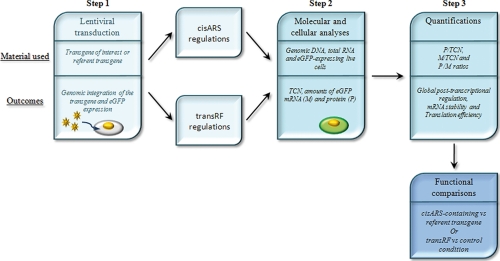Fig. 1.
FunREG. A schematic representation of the FunREG experimental pipeline is shown. The three major steps are depicted by boxes as indicated. Boxes are recognized by a title (top panel), and some, corresponding to the three major steps of the method, contain the material used (middle panel) and the biological or experimental outcomes (bottom panel), as indicated. Step 1, target cells are transduced with lentiviral particles (as illustrated) containing either the transgene of interest or the reference. Following transduction, the transgenes are integrated into the host genome, and eGFP is expressed. At this stage, the objective is either to study the functioning of known or putative cisARSs as post-transcriptional elements in selected cells, evaluate the involvement of transRFs in a cisARS-mediated post-transcriptional regulation, or perform both analyses in parallel (cisARS and transRF regulations boxes as indicated). Step 2, molecular and cellular analyses are done by measuring the “TCN” and the amounts of “M” by qPCR and qRT-PCR using genomic DNA and total RNA extracted from the whole transduced cell population, respectively. The amount of “P” is measured by flow cytometry using eGFP-expressing live cells (as illustrated). Step 3, the three ratios, P/TCN, M/TCN, and P/M, are calculated. These ratios are indicative of the global post-transcriptional regulation, the relative mRNA stability, and the relative translation efficiency, respectively. Finally the values obtained with every transgene or in every condition are compared.

